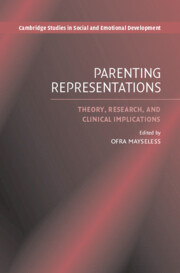Book contents
- Frontmatter
- Contents
- List of Illustrations
- List of Tables
- List of Appendixes
- List of Contributors
- Preface
- Acknowledgments
- Part One Theoretical Perspectives
- Part Two Research Applications
- Part Three Clinical Implications
- 9 Intergenerational Transmission of Dysregulated Maternal Caregiving: Mothers Describe Their Upbringing and Childrearing
- 10 Good Investments: Foster Parent Representations of Their Foster Children
- 11 Intergenerational Transmission of Experiences in Adolescence: The Challenges in Parenting Adolescents
- 12 Interplay of Relational Parent–Child Representations from a Psychoanalytic Perspective: An Analysis of Two Mother–Father–Child Triads
- 13 Why Do Inadequate Parents Do What They Do?
- Index
- Cambridge Studies in Social and Emotional Development
- References
10 - Good Investments: Foster Parent Representations of Their Foster Children
from Part Three - Clinical Implications
Published online by Cambridge University Press: 10 July 2009
- Frontmatter
- Contents
- List of Illustrations
- List of Tables
- List of Appendixes
- List of Contributors
- Preface
- Acknowledgments
- Part One Theoretical Perspectives
- Part Two Research Applications
- Part Three Clinical Implications
- 9 Intergenerational Transmission of Dysregulated Maternal Caregiving: Mothers Describe Their Upbringing and Childrearing
- 10 Good Investments: Foster Parent Representations of Their Foster Children
- 11 Intergenerational Transmission of Experiences in Adolescence: The Challenges in Parenting Adolescents
- 12 Interplay of Relational Parent–Child Representations from a Psychoanalytic Perspective: An Analysis of Two Mother–Father–Child Triads
- 13 Why Do Inadequate Parents Do What They Do?
- Index
- Cambridge Studies in Social and Emotional Development
- References
Summary
Abstract
This chapter explores the role of foster parent investment in forming parenting representations of foster children. Factors that influence foster parent investment are considered including biological unrelatedness, early emotional and physiological dysregulation, caregiving motives, and child effects. This chapter suggests that highly invested foster parenting may serve as a protective factor for children who have experienced disruptions in care. Empirical evidence is provided from several recent studies examining biologically unrelated caregivers and the importance of caregiver investment to the psychosocial development of children placed with alternative caregivers. A method for assessing foster parent investment is described. Lastly, clinical implications drawing from extant research on caregiver investment and the attachment needs of young foster children are discussed.
Foster parents become surrogate caregivers for children who have experienced disruptions in care and early inadequate care. The foster parent is not the birth parent of a foster child and therefore, may experience the internalization of the parent–child relationship differently from a biological parent. Additionally, the foster parent faces a number of potential barriers in forming optimal representations of a foster child. In this chapter, we highlight the unique contribution of foster parent investment to a foster child's emotional security and emerging sense of self. Foster parents provide care for high-risk children who may need high levels of acceptance and commitment to adjust to early caregiving failures. These caregivers face the task of becoming invested in children to whom they did not give birth and who often have uncertain placement futures.
- Type
- Chapter
- Information
- Parenting RepresentationsTheory, Research, and Clinical Implications, pp. 296 - 318Publisher: Cambridge University PressPrint publication year: 2006
References
- 3
- Cited by



